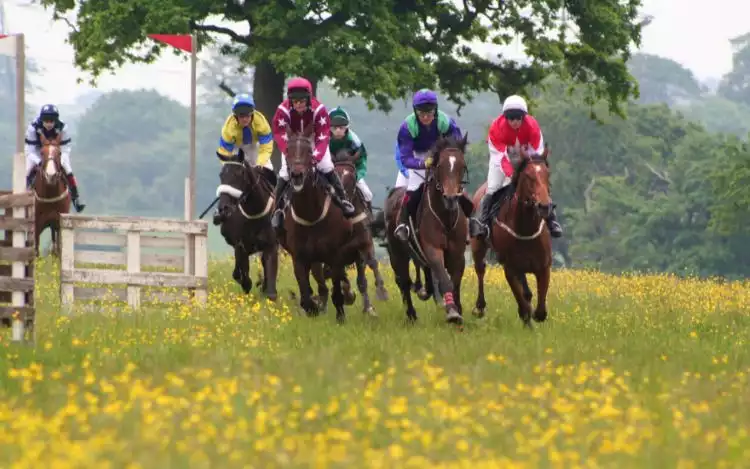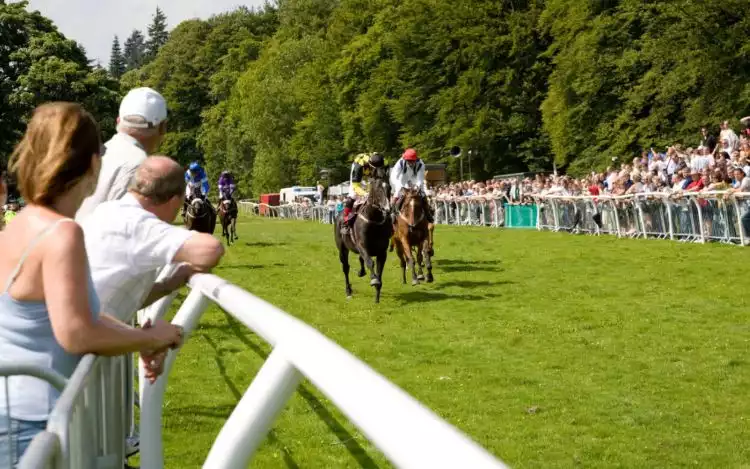Point-to-Point Horse Racing Guide
Point-to-point horse racing is not widely discussed, but it is a cherished form of the sport. It gives amateurs the chance to show their skills and can often be thought of as a hobby. However, there is much more to it than that. Discover all you need to know with our point-to-point horse racing guide.
What is Point-to-Point and How Does It Work?
Point-to-point racing, in its essence, is a grassroots form of horse racing that celebrates the spirit of simplicity and authenticity. Unlike traditional racecourses, point-to-point events are typically held on cross-country courses in rural settings, emphasising a more natural racing environment. It involves amateur riders and horses, often sourced from hunting backgrounds. It stands in stark contrast to the glitz and glamour of professional horse racing, focusing instead on the pure joy of the sport.
Competing horses jump over natural obstacles like hedges, fences, and ditches, challenging both horse and rider's mettle. Point-to-point, sometimes known as p2p, does not have grandstands and roaring crowds, making it an intimate and laid-back experience for spectators. There are still plenty of betting markets with many standard horse race bet types available. These events are often held on weekends and provide a unique opportunity for rural communities to come together, enjoy the outdoors, and share a mutual appreciation for horse racing.
Understanding the rules, the course and the strategies involved in point-to-point racing is key to fully appreciating this distinct and delightful form of horse racing.
Best Sites for Point-to-Point Racing Betting Online
BetMaze

Bet £20
Get £20
Free Bet
Quickbet

Bet £10, Get a £10 Free Bet
or a Casino Bonus of
100% up to £100
AlfoBet

Bet £20 and
Get £20 Free Bets
Brief History of Point-to-Point Racing

It began in the early 19th century in Ireland and quickly gained popularity as a celebration of farm life, and an exhibition of horsemanship.
The term "point-to-point" itself harks back to the sport's early days when races were straightforward affairs, going from one point (often a church steeple) to another. These races were initially informal gatherings of local hunting communities, where riders would compete on the horses they regularly used for hunting. The races provided an opportunity to test the horses' agility, stamina, and the skills of the riders.
As the sport evolved, it adopted more organised rules and regulations, and official racecourses were established, often in picturesque country settings. It retained its essential charm of being a sport for amateur riders and enthusiasts, and it continues to do so today.
Over time, point-to-point horse racing spread beyond Ireland, with events held in countries like the UK, France, and the United States. It has become a vital part of the equestrian calendar, drawing both riders and spectators who appreciate the unpretentious and down-to-earth nature of the sport.
Understanding the historical roots of point-to-point racing provides valuable context for appreciating its continued allure.
Different Point-to-Point Race Types
From maiden races for novice horses to the more competitive open races, point-to-point horse racing has it all. Here we explain the most popular types.
Maiden Race
Maiden races are the starting line for novice horses. Here, those who have yet to secure a victory in any previous race have their chance to shine. These races are a critical stepping stone for young and inexperienced horses, offering them valuable exposure and experience. Maiden races are known for their unpredictability, making them particularly exciting for spectators and punters, as they witness young talent striving for that elusive first win. Be wary of betting odds on these markets as they are very often not accurate as it is difficult to gauge how well a new horse will perform. So even if you know how to bet on horse racing, these can be hard to get right.
Intermediate Race
Intermediate races serve as a middle ground in point-to-point racing, involving horses that have claimed victory in a maiden or hunt members' race. These contests offer a moderate level of competition, allowing horses to advance and improve their performance. It is an ideal space for developing talent and honing skills while providing a heightened sense of competition compared to maiden races.
Open Race
Open races represent the pinnacle of point-to-point racing. They feature horses and riders of the highest calibre. What sets open races apart is that any horse can enter, irrespective of their previous wins. This inclusivity makes open races fiercely competitive, drawing top-quality talent and providing thrilling horse racing betting action for bettors.
Hunters' Chase
Hunters' chase races combine the excitement of traditional steeplechase with the spirit of point-to-point. Typically open to professional jockeys, these races involve horses with more racing experience. Participants face a variety of challenging fences and obstacles. These events offer a unique blend of horsemanship and endurance, making them a captivating spectacle for all.
Hunt Members Race
Hunt members' races are exclusive to local hunt club members who are also amateur riders. These events foster camaraderie among the community of participants, who share a passion for hunting. While the races are less competitive than others, they celebrate the essence of hunting and create a sense of unity among members.
Confined Race
Confined races are geographically restricted, allowing only horses stabled within a specific area to participate. This limitation enhances local competition and encourages a sense of community among riders and fans. Confined races are ideal for appreciating the regional talent and the close-knit nature of point-to-point racing within a particular area.
The Point-to-Point Race Season

The point-to-point race season, which runs from late autumn through early spring, includes several well-known events. Notable among them is the Grand National Point-to-Point at Aintree, held at the same course as the renowned Grand National steeplechase. Additionally, the Cheltenham Festival Hunter Chase, the Punchestown Festival Hunter Chase in Ireland, and the Foxhunter Chase at the Cheltenham Festival are widely recognised events within the point-to-point community.
These races attract top-quality horses and riders and contribute to the unique charm of point-to-point racing.
Difference Between Point-to-Point and National Hunt Racing
Both point-to-point and National Hunt races share the common thread of horses manoeuvring over obstacles in pursuit of victory. It is the heart-pounding thrill of the chase that binds them. However, the stark differences lie in the levels of professionalism and the overall experience.
Point-to-point races typically unfold in scenic farmland settings. These courses come to life as the season approaches and return to their original agricultural purposes when the season concludes. Informality and simplicity characterise point-to-point events, providing a contrast to their more structured National Hunt counterparts.
Off the racetrack, point-to-point racing cultivates a relaxed atmosphere, in sharp contrast to the rigidity of National Hunt racing. These race days are often family-oriented, allowing attendees to even bring their dogs along, provided they are kept on a leash.
In recent times, the sport has adapted to attract younger riders, often staging exclusive racing events at British meetings. This adaptation ensures that point-to-point racing remains true to its roots while staying in step with the modern era. Make no mistake; point-to-point racing is taken very seriously, and professional courses like Bangor-on-Dee and Hexam bear testimony to this commitment.
The professional aspect plays a pivotal role in distinguishing the two forms of racing. point-to-point racing is predominantly the domain of amateur riders. Local clubs or hunts typically organise race days, with regulatory oversight falling to the Point-to-Point Owners and Riders Association and the point-to-point Secretary's Association. The Jockey Club oversees the sport as a whole, ensuring alignment with other racing disciplines. Race distances also set them apart, with point-to-point races often spanning three miles, in contrast to the shorter National Hunt events, offering yet another dimension to this captivating world of horse racing.
Point-to-Point Racing Final Thoughts
Point-to-point stands as a reminder of the sport's pure origins. It is an arm of racing where amateurs, fans, and the spirit of rural communities can celebrate together. The simplicity and charm of these events are worth experiencing.
However, as with any form of gambling, responsibility is paramount. Betting should always be done with care and within your means. So, enjoy the thrill of point-to-point racing, but do so with a responsible gambler's mindset, and without risking more than you can afford.
Point-to-Point Racing FAQs
Here are the most common questions we get asked about Point-to-Point Racing.
